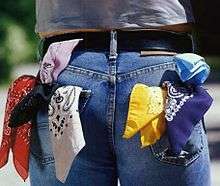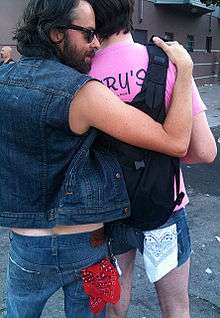Handkerchief code

| LGBT symbols |
|---|
| Flags |
| Other symbols |
The handkerchief code (also known as the hanky code, the bandana code, and flagging[1]) is a color-coded system, employed usually among the gay male casual-sex seekers or BDSM practitioners in the United States, Canada, Australia and Europe, to indicate preferred sexual fetishes, what kind of sex they are seeking, and whether they are a top/dominant or bottom/submissive.
Wearing a handkerchief on the left side of the body typically indicates one is a "top" (one considered active in the practice of the fetish indicated by the color of the handkerchief), while wearing it on the right side of the body would indicate one is a "bottom" (one considered passive in the practice of the fetish indicated by the color of the handkerchief). The hanky code was widely used in the 1970s by gay and bisexual men.
Origin

The wearing of various colored bandanas around the neck was common in the mid- and late-nineteenth century among cowboys, steam railroad engineers, and miners in the Western United States. It is thought that the wearing of bandanas by gay men originated in San Francisco after the Gold Rush, when, because of a shortage of women, men dancing with each other in square dances developed a code wherein the man wearing the blue bandana took the male part in the square dance, and the man wearing the red bandana took the female part (these bandanas were usually worn around the arm or hanging from the belt or in the back pocket of one's jeans) . It is thought that the modern hanky code started in New York City in late 1970 or early 1971 when a journalist for the Village Voice joked that instead of simply wearing keys to indicate whether someone was a "top" or a "bottom", it would be more efficient to subtly announce their particular sexual focus by wearing different colored hankies.[2] Other sources attribute the expansion of the original red–blue system into today’s code to marketing efforts around 1971 by the San Francisco department store for erotic merchandise, The Trading Post, promoting handkerchiefs by printing cards listing the meanings of various colors.[3] Alan Selby, founder of Mr. S Leather in San Francisco, claimed that he created the first hanky code with his business partners at Leather 'n' Things in 1972, when their bandana supplier inadvertently doubled their order and the expanded code would help them sell the extra colors they had received.[4]
Examples
This table is drawn from Larry Townsend's The Leatherman's Handbook II (the 1983 second edition; the 1972 first edition did not include this list) and is generally considered authoritative. Implicit in this list is the concept of left/right polarity, left as usual indicating the top, dominant, or active partner; right the bottom, submissive, or passive partner. Negotiation with a prospective partner remains important because, as Townsend noted, people may wear hankies of any color "only because the idea of the hankie turns them on" or "may not even know what it means".[5]
| Color | Meaning |
|---|---|
| Black | S&M |
| Blue (Dark) | Anal sex |
| Blue (Light) | Oral sex |
| Brown | Scat |
| Green | Hustler/prostitution |
| Grey | Bondage |
| Orange | Anything goes |
| Purple | Piercing |
| Red | Fisting |
| Yellow | Watersports |
The longer lists found on the web are more elaborate and the many color codes in them are less often used in practice, although some of these colors are offered for sale at LGBT stores along with free cards listing their meanings.
See also
References
- ↑ Andrews, Vincent (2010). The Leatherboy Handbook. The Nazca Plains Corp. ISBN 978-1-61098-046-3.
- ↑ Stryker, Susan; Van Buskirk, Jim (1996). Gay by the Bay: A History of Queer Culture in the San Francisco Bay Area. San Francisco: Chronicle Books. p. 18. ISBN 0-8118-1187-5.
- ↑ Fischer, Hal (1977). Gay Semiotics ♂. San Francisco: NFS Press. ISBN 0-917986-03-2.
In San Francisco, the signs began appearing around 1971. The Trading Post, a department store specializing in erotic merchandise, began promoting handkerchiefs in the store and printing cards with their meanings. The red and blue handkerchiefs and their significance were already in existence, and meanings were assigned to other colors as well.
- ↑ Jones, Jordy (2017). The Mayor of Folsom Street, The Auto/Biography of "Daddy Alan" Selby aka Mr. S. Fair Page Media LLC. pp. 61–62. ISBN 978-0-9989098-0-6.
- ↑ Townsend, Larry (1983). The Leatherman's Handbook II. New York: Modernismo Publications. p. 26. ISBN 0-89237-010-6.
Further reading
| Look up handkerchief code in Wiktionary, the free dictionary. |
- Jacques, Trevor H. (1993). On the Safe Edge: A Manual for SM Play. Toronto: Whole SM Publishing. ISBN 978-1-89585-705-4.